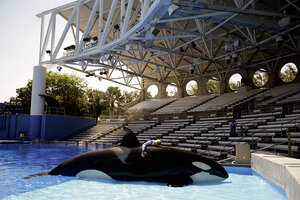Will SeaWorld's larger whale pools quell 'Blackfish' backlash?
After the documentary 'Blackfish' suggested that killer whales suffer in captivity – denting SeaWorld attendance – the park announced plans to enlarge their holding tanks. But will the move quell bad press?

A SeaWorld trainer hugs a killer whale. The company has faced documentary criticism over its treatment of captive marine animals.
John Raoux/AP
Tidal waves of criticism pummeling SeaWorld show few signs of receding, despite steps by the company to improve its whales' habitat following the release of a damning documentary.
'Blackfish,' a 2013 film, questions the park's practices in capturing the whales and investigates the 2010 killing of a trainer by a whale named Tilikum by suggesting that their confinement leads them to lash out. Since the film's premiere, attendance at SeaWorld has fallen and its stock has dropped by more than a fifth, with its Standard & Poor's credit rating plunging.
The company now says that "media attention" is to blame for the weak earnings, a reversal from previous claims that the movie did not affect its business. CEO Jim Atchison announced last week that the company would build a new 10 million-gallon whale tank in 2018, doubling the size of its old pool.
Labeled the "Blue World Project," the new tank will include a "fast water current," which simulates the ocean by allowing the whales to swim against the tide. "It’s going to be a new thing in the environment. I expect to see a whole lot of play. That’s the most exciting thing about this," a company spokesperson told FOX 5 in San Diego. “We work tirelessly day-in and day-out, to care for these animals, and that’s all our team is focused on right now.”
Will larger tanks help resolve the uncertainty on killer whales living in captivity?
Movie director Gabriela Cowperthwaite says that because the company plans to invest several hundred million dollars on the project, "the new pool size is designed to accommodate more captive whales and more forcible breeding."
When a reporter posed that exact question, the company's CEO didn't respond, reported Bloomberg. Ms. Cowperthwaite added on Friday:
“Sea World has announced it is going to expand internationally. So basically it is going to be needing more whales. So I think people in the know are sort of saying, it’s very clear that these bigger pools are going to be filled with more whales.”
Her documentary has shined outsized media attention on the challenges of raising whales in captivity, dampening interest in visiting the park.
Thirteen months since its premiere, social media continues to call for a boycott of the park, animal rights activists protest at the entrance, and musicians have canceled planned performances. On top of the bad press, 26-year corporate partner Southwest Airlines terminated its sponsorship due to public concern for the killer whales' living conditions.
What are some of the issues with capturing and raising killer whales?
'Blackfish' says that killer whales who live in captivity are more likely to suffer from disease, enjoy shorter lifespans, and suffer emotional trauma from being separated from their families.
Animal rights groups also object to the process by which SeaWorld captures the whales, imprisons them outside of their natural habitat, and forces them to perform tricks.
According to an Al Jazeera report on the whales:
In 1983, a male orca was captured in the North Atlantic. At two years of age, he was already 11.5 feet long. His captors named him Tilikum. A number of Tilikum's trainers speak candidly in Blackfish about his miserable life at Sealand in Victoria, Canada. When he was just four years old, he was 16-feet-long and weighed 4,000 pounds. Former Sealand trainers said Tilikum and two other orcas were locked in a 20-by-30 foot dark metal container for two-thirds of their lives. There was no stimulation, they were mostly immobile for 14 hours a day, and the trainers punished and deprived them of food in order to make them perform tricks.
The physical trauma, coupled with the emotional distress of being taken from his family and home, took a major toll on Tilikum, pushing the animal to aggression.
In 1991, Tilikum killed trainer Keltie Byrne. On February 24, 2010, Tilikum brutally attacked and killed veteran SeaWorld Orlando whale trainer Dawn Brancheau.
Despite the bad press and lower stock price, the park's operators are still profitable. Private equity firm Blackstone Group owns the three SeaWorlds in Orlando, Fla., San Antonio, Texas, and San Diego, Calif., and since purchasing the parks in 2009, the group "is reeling in the profits from its aquarium theme park," reported the Wall Street Journal.

